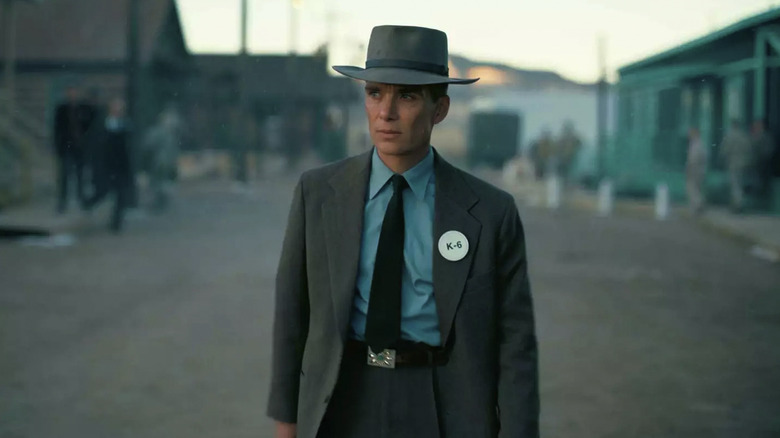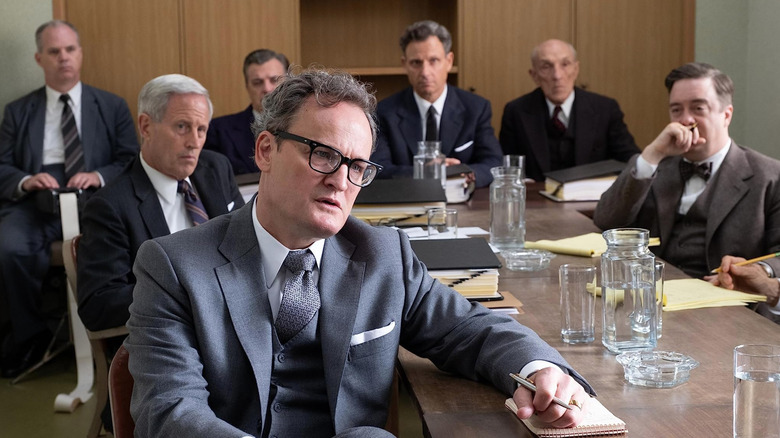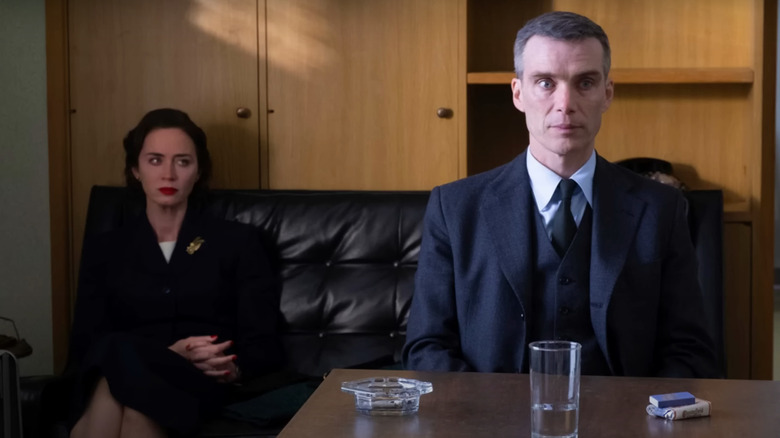Cillian Murphy's Favorite Oppenheimer Scenes Were The Most Harrowing To Film
This post contains spoilers for "Oppenheimer."
Cillian Murphy wasn't about to phone in his "Oppenheimer" performance. The actor had been waiting since 2005, when he played The Scarecrow/Dr. Jonathan Crane in Christopher Nolan's "Batman Begins," to take the lead in one of the director's films. In the almost 20 years since that movie debuted, Murphy has worked with the revered filmmaker an additional five times, the most recent of which saw him finally take the lead as the titular theoretical physicist in Nolan's "Oppenheimer."
Not only did the actor basically eat next to nothing in order to match Oppie's slender frame, but during his six months of prep time Murphy watched two movies specifically to prepare for the role: David Lean's 1962 epic "Lawrence of Arabia," and Miloš Forman's 1984 film "Amadeus." Both films aren't without their darker moments, but neither compare to the bleakness that underlies Nolan's latest. That bleakness comes to a head with the chilling ending to "Oppenheimer," which suggests the human race's destruction could be all but certain thanks to the titular physicist's efforts.
That final image of Murphy's Oppenheimer intensely staring into space as he grapples with the moral implications of his life's work symbolizes the darkness at the heart of "Oppenheimer." But while it must have taken a lot for Murphy to summon a feeling of existential dread and dismay in order to convey his character's inner world in that moment, it was apparently nothing compared to having to film the security clearance hearing scenes.
'Emotional and heavy in a brilliant way'
Christopher Nolan shot "Oppenheimer" using 70mm IMAX cameras. The director famously champions the format as the sharpest, most immersive available, and even challenged Kodak to develop black and white IMAX film for his latest effort. That seems to have paid off as "Oppenheimer" has had its IMAX run extended following an impressive debut that saw the movie pass $400 million at the box office after its second weekend in theaters.
But it can't have been easy to drag giant IMAX cameras into a tiny meeting room in order to shoot the security clearance hearing scenes. Instigated by Robert Downey Jr.'s Lewis Strauss in the years after the Trinity Test, the hearings are led by several arbitrators tasked with basically dismantling Oppenheimer's reputation. Chief among them is Jason Clarke's special counsel Roger Robb, whose fiery dressing down of the physicist and his associates makes him one of the most memorable antagonists in "Oppenheimer," despite Clarke's role being relatively slight.
According to Murphy, these scenes were some of the most challenging, and rewarding, to film. As he told Collider:
"The section of the movie that I loved working on the most was the section in the room, in 2022, when we were all in the hearing. We shot in this tiny, s****y little room. There weren't any moveable walls or anything like that; it was just all of us in there with this huge camera. That felt almost like doing a play. We did that for two weeks, so all these incredible actors, Jason Clarke and everybody, would come in and do their piece. I found that very emotional and heavy, but in a brilliant way. It was a real challenge. So, that was my favorite chunk of the movie in terms of shooting."
It's all about immersion
Most fans of Christopher Nolan will be familiar with his preference for shooting practically. That extends beyond just blowing up a real plane for "Tenet" or recreating a nuclear explosion without CGI for "Oppenheimer." In the case of the latter, it also compelled the director to cram his cast and a giant IMAX camera into a real meeting room that could barely contain them all.
While that couldn't have been a pleasant experience, it likely helped enhance the sense of pressure Cillian Murphy had to channel in order to portray Oppenheimer's exasperation in the moment. The scientist basically had to watch as the US government systematically destroyed his reputation in real time by interrogating him and every associate and friend he'd ever had, and Murphy did a stellar job of portraying the various emotions stirred up over the course of these meetings (including a sense of self-flagellation).
Nolan could easily have had a room built for the hearing scenes which would have allowed him to remove walls and place that bulky IMAX camera wherever he liked. But by shooting in a real room, he not only gave the actors more to work with in terms of putting them in a scenario as close to the reality as possible, he also put the audience in that situation. That was the director's stated aim for the movie as a whole, with Nolan extolling the virtues of IMAX as a way to really immerse his viewers in Oppenheimer's first-hand experience. Shooting intense scenes in real-life locations was just another element that helped achieve that goal.


